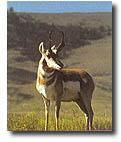
Other Mammals of Yellowstone - J Zumbo
Pronghorn
|
 These are the fastest mammals in North America, capable of running
at speeds in excess of 55 mph. They also have tremendous vision,
equal to that of a powerful telescope. Unlike other animals that
seek heavy vegetation for escape cover, pronghorns are more secure
in the open where their superior eyesight allows them to spot danger
at long distances. These animals are tough, able to withstand ferocious
prairie blizzards without seeking shelter. They're tolerant to severe
cold because their hair Is hollow, offering more insulation in strong
winds. Pronghorn are unique in that they rarely jump fences, unlike
all other large hoofed mammals. Instead, they go under the bottom
wire, or find a spot where the fence has been damaged, allowing
them to get through. These are the fastest mammals in North America, capable of running
at speeds in excess of 55 mph. They also have tremendous vision,
equal to that of a powerful telescope. Unlike other animals that
seek heavy vegetation for escape cover, pronghorns are more secure
in the open where their superior eyesight allows them to spot danger
at long distances. These animals are tough, able to withstand ferocious
prairie blizzards without seeking shelter. They're tolerant to severe
cold because their hair Is hollow, offering more insulation in strong
winds. Pronghorn are unique in that they rarely jump fences, unlike
all other large hoofed mammals. Instead, they go under the bottom
wire, or find a spot where the fence has been damaged, allowing
them to get through.
Pronghorn are found in sizable
herds throughout the west with the exception of Washington. They're
fond of sagebrush prairies, but are also quite happy in lush alfalfa
fields. The only place you'll regularly see them in Yellowstone
Is in the area between Gardiner and Mammoth. Outside Yellowstone,
look for them along 1-15 north and south of Dillon, Montana; in
the desert and farmland country around dark, Wyoming; and along
the highway between Cody and Thermopolis, Wyoming.
|
Mountain
Goats
|
These amazing animals inhabit the
most precarious terrain in North America. Mountain goats are strictly
high-altitude residents, preferring to live in and around sheer
rock walls and cliffs where they seemingly dely gravity. Pure
white In color, the goats are easy to spot in the summer. Conversely,
they're almost impossible to see in the winter when they blend
in with snow. Females are called nannies; males are billies. Both
sexes have black horns that are seven to nine inches in length.
Typically, a billy's horns are a bit thicker than those of the
female. Goats are very rare
In Yellowstone, but you can see them quite frequently along the
Beartooth Highway in Wyoming and Montana.
"The Essenstials
for Planning your
Trip to Yellowstone Park" |
|
|
|
|
|
Mountain
Lions
|
| These large cats roam throughout
the west, and lately have been causing problems in urban areas.
Increased attacks on humans and pets most likely are because of
civilization's encroachment into habitat normally occupied by lions.
In the Yellowstone area, mountain lions, also known as cougars,
are residents of the backcountry and are rarely seen. These predators
may weigh up to 170 pounds and reach lengths of eight feet from
nose to tail. Males are larger than females. Lions are meat-eaters
and prefer their menu fresh. Deer are among their favorite prey
species, but they'll also catch other animals such as beavers, rabbits,
porcupines and various rodents. Contrary to popular belief, lions
do not ambush their prey from a tree limb as the hapless quarry
walks underneath. Instead, the cat makes an incredibly stealthy
stalk, using vegetation as screening cover. When it's just a short
distance away, the lion makes a quick charge and either catches
the prey in the first few bounds or misses it. During long chases,
deer can usually outrun a lion, but the Initial surprise attack
is a most successful strategy. Seeing a lion anywhere in the west
is cause for great celebration. Don't expect to see one, but if
you do, consider yourself very fortunate. Typically, lions dwell
in places where there are plenty of deer.
|
|

